The use of negative numbers in real life situations. Presentation for a research paper in mathematics "negative numbers in the modern world"
Recall what numbers you already know. Did you start your study with natural numbers, those numbers that we use when counting, such as 1, 2, 3, 4 ... etc. Then we found out that we lack such numbers. For example, if you divide a segment of length 1 in half, then the length of the resulting segment will not be integer. So we got acquainted with fractional numbers, such as , , . So, we remembered that there are natural numbers and there are fractional numbers, but it turns out that they are not enough either. Let's look at this with an example.
You have 40 rubles. and you want to buy ice cream for 20 rubles. How much money will you have left after the purchase? (see fig. 1).

Rice. 1. Ice cream for 20 rubles.
Now imagine a slightly different situation. You have 20 rubles and you want to buy ice cream for 40 rubles. How much money will you have then? (see Fig. 2).
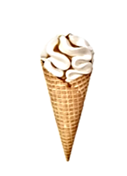
Rice. 2. Ice cream for 40 rubles.
It can be solved by analogy:
But 20 is less than 40. And having 20 rubles, ice cream for 40 rubles. cannot be bought. You can borrow 20 rubles. And only then buy ice cream. But what will be left after that?
There will be a debt of 20 rubles. You can express this debt as a number by entering negative numbers.
Similar prerequisites arise on the number axis.
Consider the number axis (see Fig. 3).

Rice. 3. Number axis
Natural numbers 1, 2, 3, etc. are marked on it, and the beginning is at the point zero. Also on the corresponding segments we can mark the numbers , , etc. (see Fig. 4).

Rice. 4. Number axis
Which means, We add three units to 1 and get to point 4 (see Fig. 5).
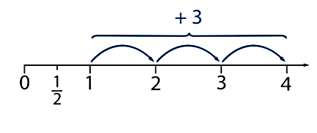
Rice. 5. Number line
Similarly, we can take a step in the other direction. For example, what happens if we subtract 3 from 1: ? We will fall into the void (see Fig. 6).

Rice. 6. Number axis
Here are the negative numbers that we will certainly need (see Fig. 7).

Rice. 7. Number axis
Now we can enter them. But what about negative numbers? To do this, let's remember how natural numbers are denoted, such as 1, 2, 3, 4, etc. (see Fig. 8).

Rice. 8. Number axis
But what does number 2 show? It shows that two unit segments are placed from 0 to 2 (see Fig. 9).

Rice. 9. Number axis
If we postpone the same segment to the left, we will get the distance from point 0 in exactly one segment. So we get the number 1. But in order not to get confused, for the numbers on the left they came up with special sign"-", which we put in front of the number and get. Similarly, the next number will be, etc. That is, if we denote natural numbers as 1, 2, 3, etc., then negative ones as -1, -2, -3. (See Fig. 10) .

Rice. 10. Number axis
There is a number, for it there is an opposite number. It is between -2 and -1 and equals - (see Fig. 11).
![]()
Rice. 11. Number axis
Let's go back to the first example. We had 20 rubles. and we spent 40 rubles, we have -20 rubles left.
How to deal with negative numbers, how to add, subtract, etc. are the topics of later lessons. Now let's think about where real life are negative numbers applied?
On some outdoor thermometers, the temperature is shown like this: there is a bar of zero degrees, there is something that is above zero - 1, 2, 3, etc., and there is something that is below zero, and is indicated by negative numbers -1, -2, - 3, etc. (see fig. 12).
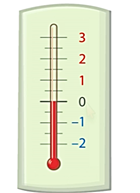
Rice. 12. Thermometer
Another -1 degree is called 1 degree of frost, and +1 degree - one degree of heat. That is, both there and there 1, but instead of the minus sign, we use the words “frost”. And when we don’t want to use it, we say: “The air temperature is -20 degrees” (see Fig. 13).

Rice. 13. Air temperature
This means a minus, that from zero we do not go up, but down.
Water level in the river (see Fig. 14).
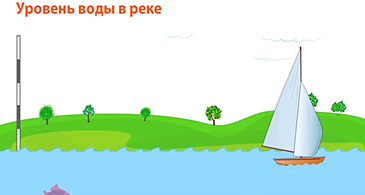
Rice. 14. Water level in the river
As you know, the water level in a river can rise and fall. So, if the water level has risen by 5 cm, they say: “Changed by +5 cm” (see Fig. 15).
![]()
Rice. 15. Water level in the river
If it has dropped by 5 cm, then they say “The water level has changed by -5 cm” (see Fig. 16). 
Rice. 16. Water level in the river
Both there and there the water level changed by 5 cm, but when it rose, they say +5 cm, and when it dropped - by -5 cm.
As you can see, negative numbers are used where the value can change in both directions. That is, when we talked about cash settlements, you may still have change - this is “+”, and if you owe someone, then this is “-”. The temperature can be above zero - this is "+", and below zero - this is "-". The water level can rise - "+", and fall - "-".
Let's consider one more example.
The entrepreneur owns a company selling apples, and in January he earned a net profit of 500 rubles, and in February - 800 rubles. In March, apples were bought worse, and he remained at a loss, namely, his profit amounted to -200 rubles. (see fig. 17).

Rice. 17. Cash flow

Rice. 18. Cash flow
More similarly about actions with negative numbers can be found in the following lessons.
Today we found out that the numbers that we knew before - natural (1, 2, 3 ... etc.) and fractional (, , ) are not enough for some practical purposes, so we introduced negative (-1, -2, -3... etc.).
Negative numbers on the number line are to the left of zero. There can be not only negative integers, but also fractional ones. And we found out where negative numbers can occur, namely where the value can be increased and decreased. So it was when measuring temperature, water level and measuring income and expenses.
Bibliography
- Vilenkin N.Ya., Zhokhov V.I., Chesnokov A.S., Shvartsburd S.I. Mathematics 6. - M.: Mnemosyne, 2012.
- Merzlyak A.G., Polonsky V.V., Yakir M.S. Mathematics 6th grade. - Gymnasium. 2006.
- Depman I.Ya., Vilenkin N.Ya. Behind the pages of a mathematics textbook. - M.: Enlightenment, 1989.
- Rurukin A.N., Tchaikovsky I.V. Tasks for the course of mathematics grade 5-6. - M.: ZSh MEPhI, 2011.
- Rurukin A.N., Sochilov S.V., Tchaikovsky K.G. Mathematics 5-6. Allowance for 6th grade students correspondence school MEPhI. - M.: ZSh MEPhI, 2011.
- Shevrin L.N., Gein A.G., Koryakov I.O., Volkov M.V. Mathematics: Interlocutor textbook for grades 5-6 high school. - M .: Education, Mathematics Teacher Library, 1989.
Table 1
3. The crossbill bird lays eggs and incubates chicks in winter. Even at the air temperature in the nest, the temperature is not lower. By how much is the temperature in the nest higher than the air temperature?
"The History of Negative and Positive Numbers"
Pavlenko Alina 6 "B" class
Head: Osmolovskaya O.A. - mathematic teacher
Moscow, 2014
1. Introduction…………………………………………………………………………………
2.History of positive and negative numbers…………….……
3. The origin of the words "plus" and "minus"…………………….………..
4.Conclusion…………………………………………………………………………….
5. Bibliography…………………………………………………………………………
INTRODUCTION
"A History of Negative and Positive Numbers". I chose this topic because I want to learn more about positive and negative numbers, that is, to expand my horizons. I would also like to know how people learned to perform actions with positive and negative numbers, when it happened, what is the history of these numbers when they first appeared.I want to learn as much as possible about the origin of numbers, about their meaning in our lives.I want to show students, as well as teachers, the beauty and fun of the subject of mathematics, going beyond the textbook.
C spruce work:
Development of research competence through the development of new knowledge within the framework school project"Actions with positive and negative numbers".
Tasks:
Build skills independent work with educational material;
Use knowledge in real life;
To form the ability to think logically, reason consistently and present the final result
History of positive and negative numbers
People could not get used to negative numbers for a long time. Negative numbers seemed incomprehensible to them, they were not used, they simply did not see much meaning in them.These numbers appeared much later than natural numbers and ordinary fractions.
The first information about negative numbers is found among Chinese mathematicians in the 2nd century BC. BC e. and thenonly the rules for adding and subtracting positive and negative numbers were known; multiplication and division rules were not applied.Positive numbers in Chinese mathematics were called "chen", negative - "fu"; they were portrayed different colors: "chen" - red, "fu" - black. This can be seen in the book Arithmetic in Nine Chapters (Author Zhang Can). This method of representation was used in China until the middle of the 12th century, until Li Ye proposed a more convenient notation for negative numbers - the numbers that depicted negative numbers were crossed out with a dash obliquely from right to left.
Only in the 7th century Indian mathematicians began to make extensive use of negative numbers, but regarded them with some distrust.Bhashara directly wrote: "People do not approve of abstract negative numbers ...".Here is how the Indian mathematician Brahmagupta set out the rules of addition and subtraction: “property and property are property, the sum of two debts is debt; the sum of property and zero is property; the sum of two zeros is zero ... Debt, which is subtracted from zero, becomes property, and property becomes debt. If it is necessary to take property from debt, and debt from property, then they take their amount. "The sum of two properties is property."
(+x) + (+y) = +(x + y) (-x) + (-y) = - (x + y)
(-x) + (+ y) = - (x - y)(-x) + (+ y) = + (y - x)
0 - (-x) \u003d + x 0 - (+ x) \u003d -x
The Indians called the positive numbers "dhana" or "swa" (property), and the negative ones - "rina" or "kshaya" (debt). Indian scientists, trying to find examples of such a subtraction in life, came to interpret it from the point of view of trade calculations. If the merchant has 5000 r. and buys goods for 3000 rubles, he has 5000 - 3000 \u003d 2000, r. If he has 3,000 rubles and buys for 5,000 rubles, then he remains in debt for 2,000 rubles. In accordance with this, it was believed that a subtraction of 3000 - 5000 is being made here, but the result is the number 2000 with a dot at the top, meaning "two thousand debt." This interpretation was artificial, the merchant never found the amount of the debt by subtracting 3000 - 5000, but always subtracting 5000 - 3000.
A little later in ancient india and China guessed instead of the words "debt of 10 yuan" simply write "10 yuan", but draw these hieroglyphs in black ink. And the signs "+" and "-" in ancient times were neither for numbers, nor for actions.
The Greeks also did not use signs at first. The ancient Greek scientist Diophantus did not recognize negative numbers at all, and if a negative root was obtained when solving an equation, then he discarded it as "inaccessible". And Diophantus tried to formulate problems and make equations in such a way as to avoid negative roots, but soon Diophantus of Alexandria began to denote subtraction with a sign.
Rules for dealing with positive and negative numbers were proposed as early as the 3rd century in Egypt. The introduction of negative quantities first occurred in Diophantus. He even used a special character for them. At the same time, Diophantus uses such turns of speech as “Let us add the negative to both sides,” and even formulates the rule of signs: “A negative multiplied by a negative gives a positive, while a negative multiplied by a positive gives a negative.”
In Europe, negative numbers began to be used from the 12th-13th centuries, but until the 16th century. most scientists considered them "false", "imaginary" or "absurd", in contrast to positive numbers - "true".Positive numbers were also interpreted as "property", andnegative - as "debt", "shortage". Even the famous mathematician BlaisePascal
argued that 0 − 4 = 0, since nothing can be less than nothing. In Europe, the idea of a negative quantity is enoughcame close at the beginning of the XIII century, Leonardo Fibonacci of Pisa. In a competition in solving problems with the court mathematicians of Frederick II, Leonardo of Pisa was asked to solve a problem: it was required to find the capital of several persons. Fibonacci got negative meaning. "This case," said Fibonacci, "is impossible, except to accept that one had not capital, but debt." However, explicitly negative numbers were used for the first time at the end of the 15th century by the French mathematician Shuquet. Author of a handwritten treatise on arithmetic and algebra, The Science of Numbers in Three Parts. Schücke's symbolism is approaching the modern one.
The work of the French mathematician, physicist and philosopher Rene Descartes contributed to the recognition of negative numbers. He proposed a geometric interpretation of positive and negative numbers - he introduced the coordinate line. (1637).
Positive numbers are depicted on the number axis by points lying to the right of the origin 0, negative - to the left. The geometric interpretation of positive and negative numbers contributed to their recognition.
In 1544, German mathematician Michael Stiefel considers negative numbers for the first time as numbers less than zero (i.e. "less than nothing"). From that moment on, negative numbers are no longer viewed as a debt, but in a completely new way. Stiefel himself wrote: “Zero is between true and absurd numbers…”
Almost simultaneously with Stiefel, Bombelli Raffaele (circa 1530-1572), an Italian mathematician and engineer who rediscovered the work of Diophantus, defended the idea of negative numbers.
Similarly, Girard considered negative numbers quite acceptable and useful, in particular, to indicate the lack of something.
Every physicist constantly deals with numbers: he always measures something, calculates, calculates. Everywhere in his papers - numbers, numbers and numbers. If you look closely at the records of a physicist, you will find that when writing numbers, he often uses the signs "+" and "-". (For example: thermometer, depth and height scale)
Only at the beginning of the XIX century. the theory of negative numbers has completed its development, and "absurd numbers" have received universal recognition.
The origin of the words "plus" and "minus"
The terms come from the words plus - "more", minus - "less". At firstactions were denoted by the first letters p; m. Many mathematicians preferred or The emergence of modern signs "+", "-" is not entirely clear. The “+” sign probably comes from the abbreviation et, i.e. "And". However, it may have originated from trade practice: the sold measures of wine were marked on the barrel with a “-”, and when the stock was restored, they were crossed out, a “+” sign was obtained.
In Italy, moneylenders, lending money, put in front of the name of the debtor the amount of the debt and a dash, like our minus, and when the debtor returned the money, they crossed it out, something like our plus.
Modern these signs "+" and appeared in Germany in last decade XV century in the book of Widmann, which was a guide to the account for merchants (1489). Czech Jan Widman already wrote "+" and "-" for addition and subtraction.
A little later, the German scholar Michel Stiefel wrote the Complete Arithmetic, which was published in 1544. It contains such entries for numbers: 0-2; 0+2; 0-5; 0+7. Numbers of the first kind he called "less than nothing" or "lower than nothing". Numbers of the second type he called "more than nothing" or "higher than nothing". Of course, you understand these names, because "nothing" is 0.
Other designations were also proposed, images were invented.
United signsfirst found in Girard (1626) in the form.
This entry has been superseded by icons And .
Secondary mergedinvented the Portuguese da Cunha (1790), in which they looked like this: And .
Conclusion
Most people knew negative numbers. All scientists had different opinions. Someone thought that it was “wrong”, “absurd”, and some considered it acceptable and solved problems and equations with them.
Negative numbers are most common in the exact sciences, in mathematics and in physics.
In physics, negative numbers arise as a result of measurements, calculations physical quantities. Negative number - shows the magnitude of the electric charge. In other sciences, like geography and history, a negative number can be replaced by words, for example, below sea level, and in history - 157 BC.
Bibliography:
Internet
Vigasin A.A., Goder G.I., "History ancient world"Textbook 5th grade, 2001.
Gelfman E.G. "Positive and negative numbers", math textbook for grade 6, 2001.
Children's encyclopedia "I know the world", Moscow, "Enlightenment", 1995.
Fridman L. M.. "Studying Mathematics", educational edition, 1994
Malygin K.A.
Nurk E.R., Telgmaa A.E. "Mathematics Grade 6", Moscow, "Enlightenment", 1989
Glazer G. I. "History of mathematics at school", Moscow, "Prosveshchenie", 1981
Great Mathematical Encyclopedia. Yakusheva G.M. and etc.
The emergence and development of mathematical science: Book. For the teacher. - M .: Education, 1987.
Head. ed. M. D. Aksyonova. – M.: Avanta+, 1998.
History of mathematics at school, IV-VI grades. G.I. Glazer, Moscow, Education, 1981.
E.G. Gelfman et al., Positive and negative numbers in the Pinocchio theater. Tutorial in mathematics for 6th grade. 3rd edition, corrected, - Tomsk: Publishing House Tomsk University, 1998
"Student's Handbook". Publishing House VES, St. Petersburg. 2003
Textbook 5th grade. Vilenkin, Zhokhov, Chesnokov, Schwarzburd.
"The History of Mathematics in Antiquity", E. Kolman.
"History of the Ancient World", Grade 5. Kolpakov, Selunskaya.
"Encyclopedia for children. Mathematics", Publishing house "Avanta"
Positive
and negative
numbers around us
6th grade students
Baturin Alexander, Shatilova Xenia
graphic designer, 11th grade student
Telyakova Ksenia
Supervisor
mathematic teacher
Samofalova T.P.
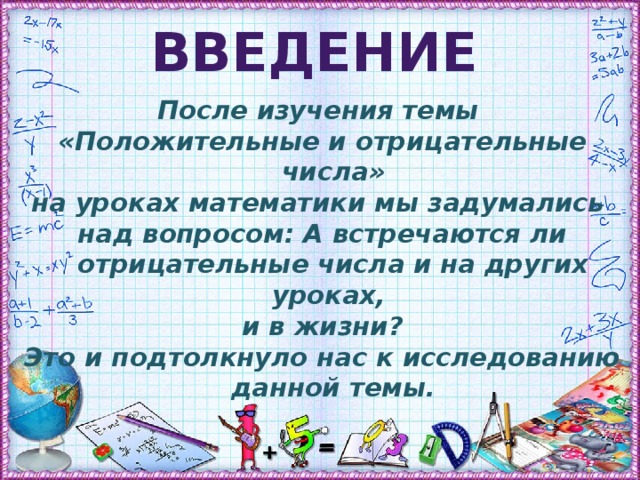
Introduction
After studying the topic
"Positive and Negative Numbers"
in math class we thought
over the question: Are there negative numbers in other lessons,
and in life?
This prompted us to explore this topic.
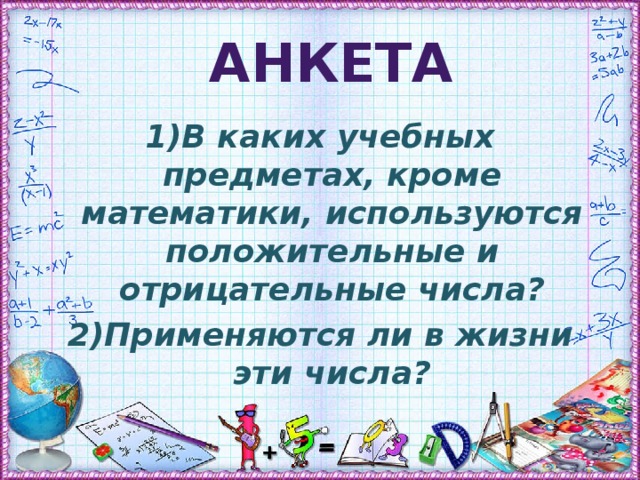
QUESTIONNAIRE
1) In what subjects, besides mathematics, are positive and negative numbers used?
2) Do these numbers apply in real life?
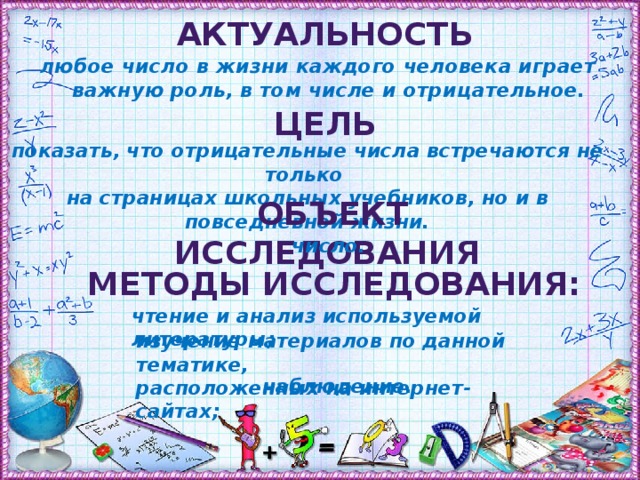
RELEVANCE
any number in the life of every person plays important role, including the negative.
goal
show that negative numbers occur not only
on the pages of school textbooks, but also in everyday life.
OBJECT OF STUDY
number.
RESEARCH METHODS:
reading and analysis of used literature;
study of materials on this topic,
located on websites;
observation.

Tasks:
- expanding knowledge about positive and negative numbers;
- research on the use of negative numbers in physics, geography, history, biology, economics;
- increasing interest in learning mathematics;
- presentation in front of classmates.
hypothesis :
negative numbers are found not only in mathematics, but also in other sciences.

Negative numbers
in geography :
Height and depth measurement more
since ancient times it has been interesting to man .
It is convenient to record measurement results using positive and negative numbers.
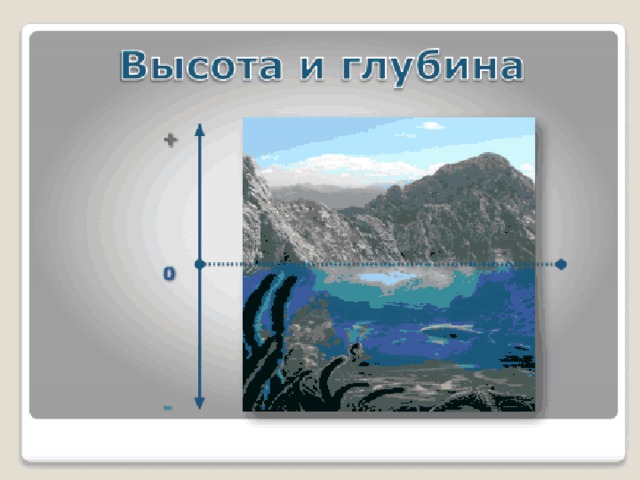

SEA DEPTHS
Measured using negative numbers

MOUNT EVEREST
Everest- highest peak the globe height according to various sources from +8844 to +8852 meters is located in the Himalayas.
Located on the border of Nepal and China, the peak itself lies on the territory of China.
Has the shape of a pyramid; the southern slope is steeper.
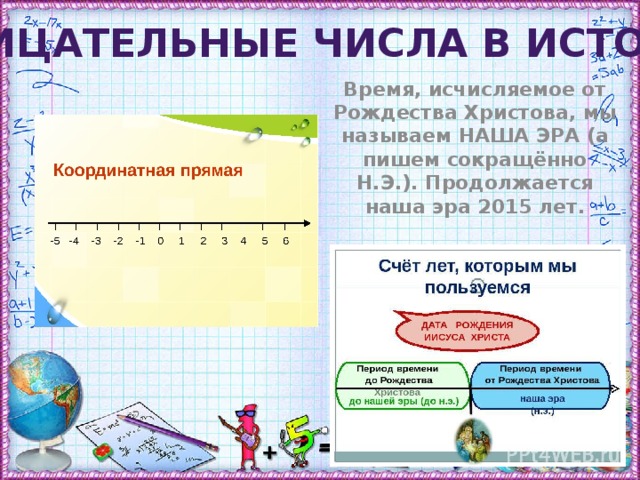
Negative numbers in history
The time counted from the Nativity of Christ, we call OUR ERA (and we write NE for short). Our 2015 era continues.
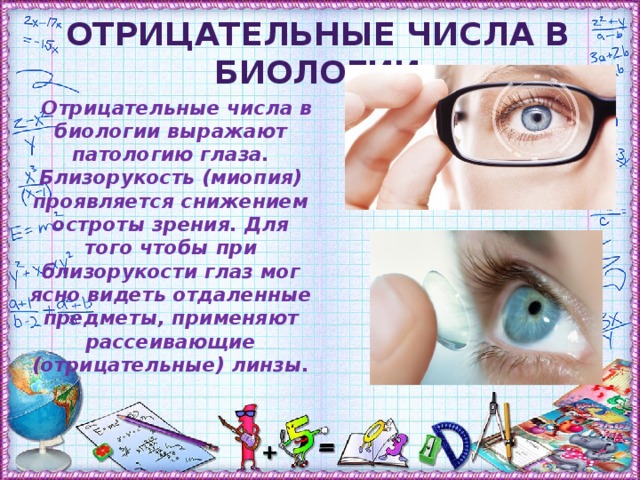
Negative numbers in biology express the pathology of the eye. Nearsightedness (myopia) is manifested by a decrease in visual acuity. In order for the eye to be able to see distant objects clearly, diffusing (negative) lenses are used.
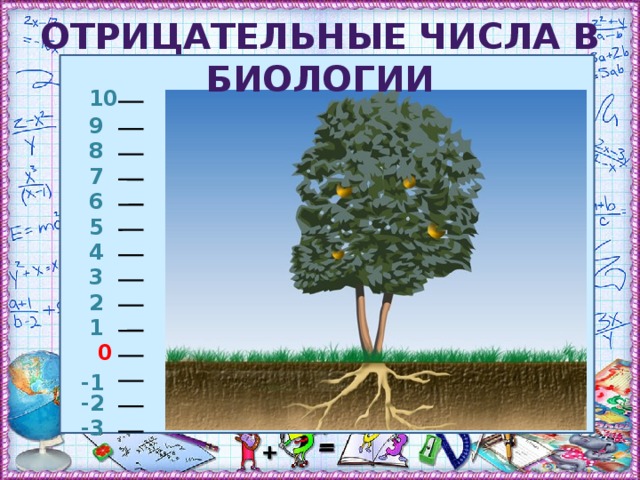
Negative numbers in biology
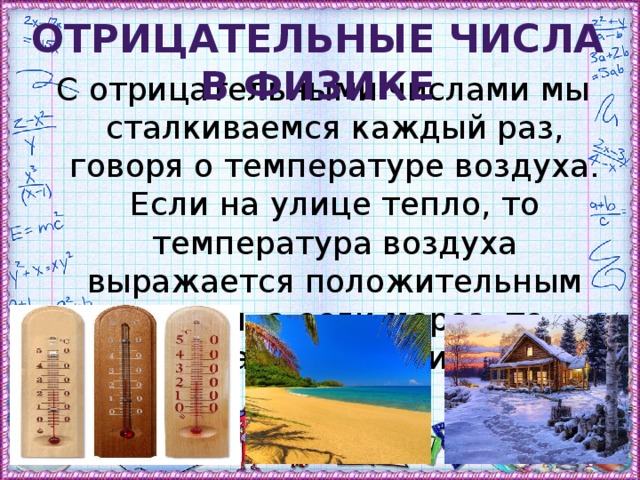
Negative numbers in physics
We encounter negative numbers every time we talk about air temperature. If it is warm outside, then the air temperature is expressed as a positive number, and if it is cold, then as a negative number.
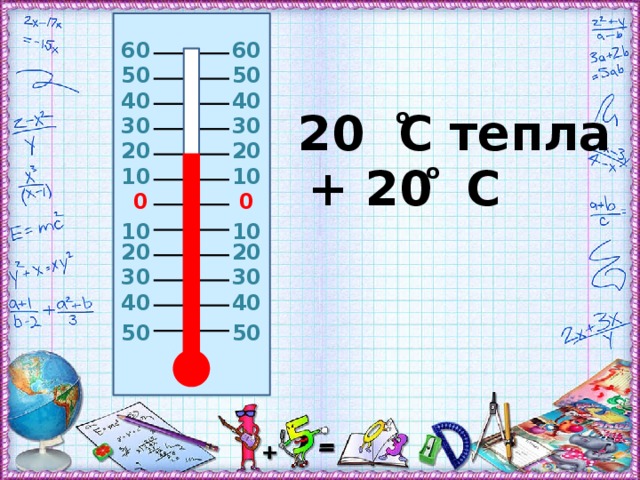
20 C heat
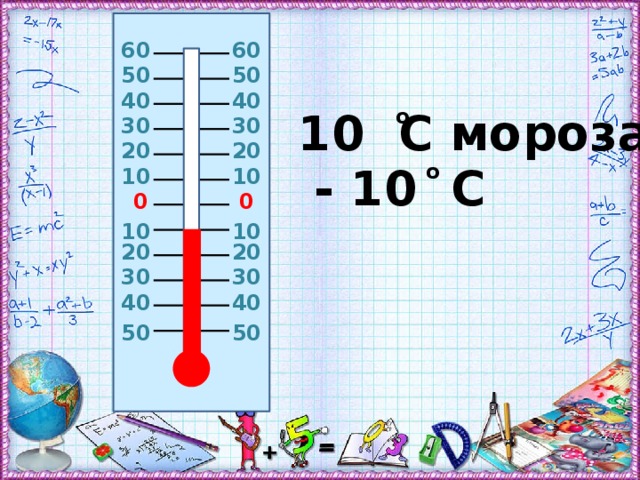
10 C frost

POSITIVE AND NEGATIVE NUMBERS
ON THE FAST HIGHWAY
The speed of cars moving to the right is considered positive, and to the left - negative. The sign of the number will indicate the direction of the speed (movement) of the cars.
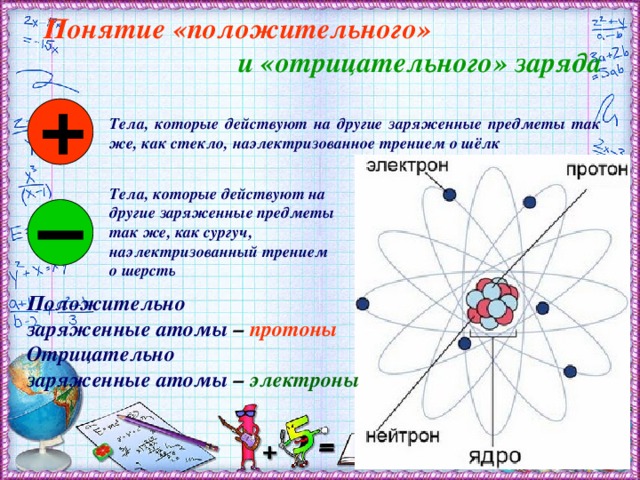
The concept of "positive"
and "negative" charge
Bodies that act on other charged objects in the same way as glass electrified by rubbing against silk
The bodies that Act on
other charged items
just like sealing wax,
electrified by friction
about wool
Positively
charged atoms – protons
negative
charged atoms – electrons

By rubbing the paws against the abdomen, the mosquito causes electricity
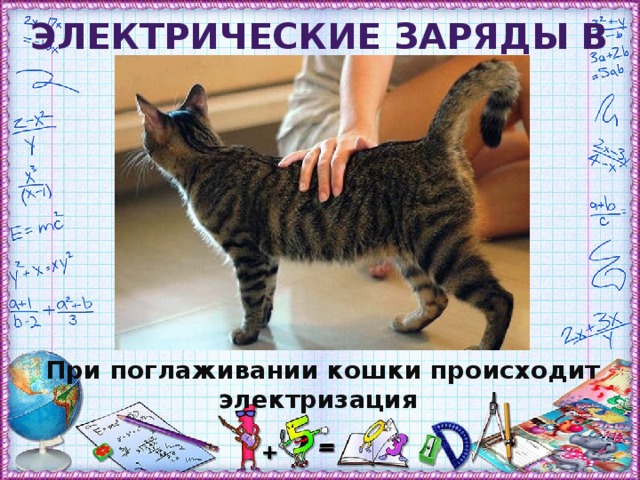
Electric charges in nature
Electrification occurs when stroking a cat
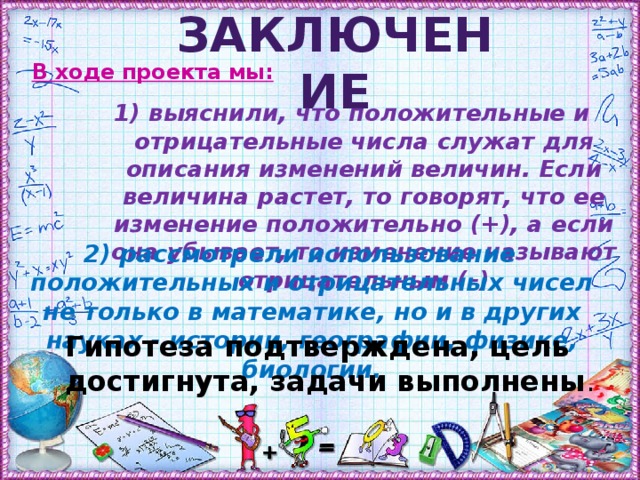
Conclusion
During the project we:
1) found out that positive and negative numbers serve to describe changes in quantities. If the value increases, then they say that its change is positive (+), and if it decreases, then the change is called negative (-)
2) considered the use of positive and negative numbers not only in mathematics, but also in other sciences - history, geography, physics, biology.
The hypothesis is confirmed, the goal is achieved, the tasks are completed .
